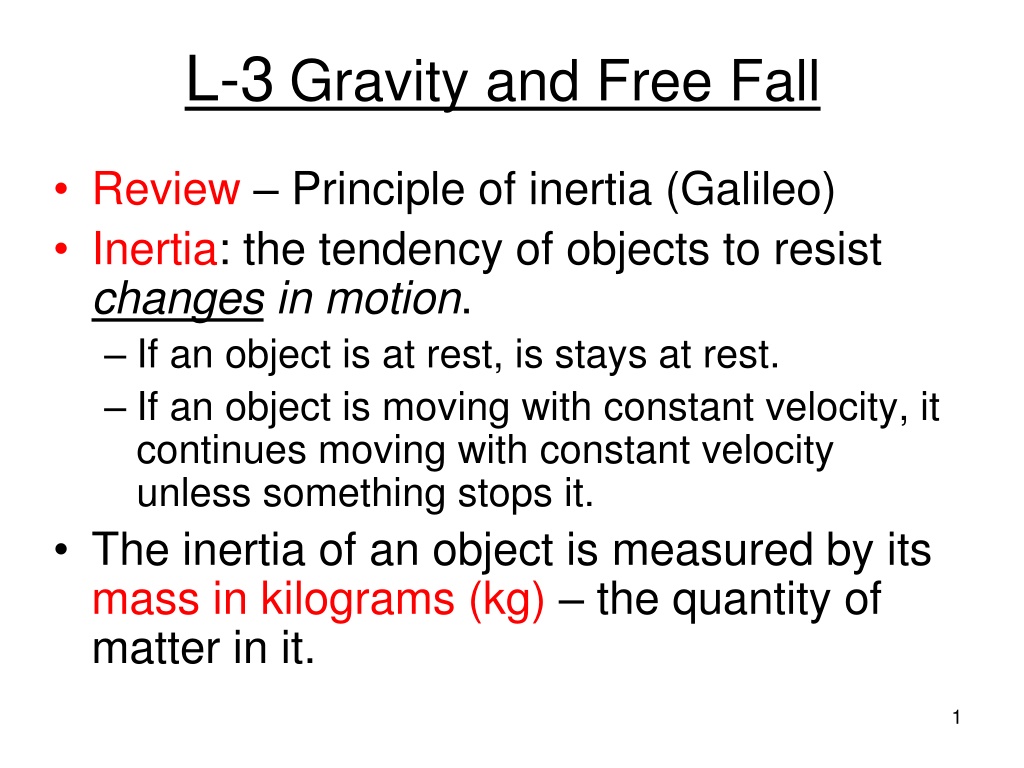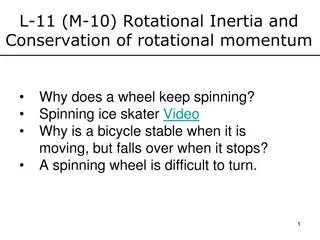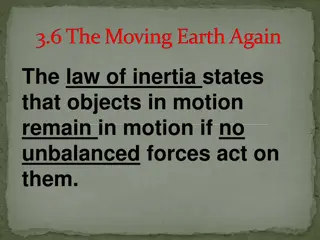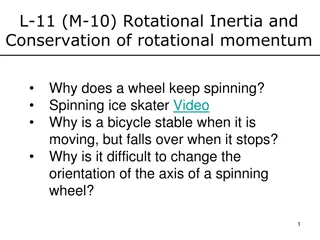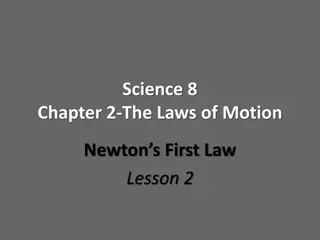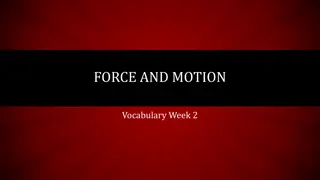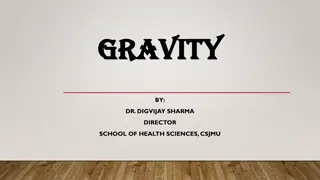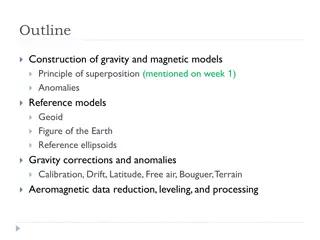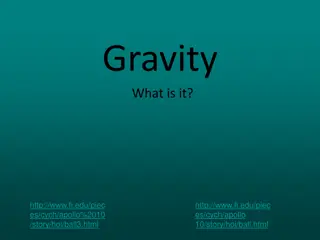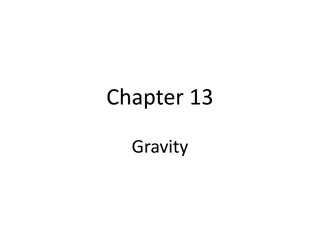Understanding Gravity and Inertia: Key Concepts in Motion
Exploring the principles of inertia and gravity, this content delves into how objects resist changes in motion and the force that attracts objects towards each other. From Newton's Law of Gravity to the dynamics of free fall and weight, learn how these fundamental concepts shape our understanding of the universe and keep celestial bodies in motion within the solar system.
Download Presentation

Please find below an Image/Link to download the presentation.
The content on the website is provided AS IS for your information and personal use only. It may not be sold, licensed, or shared on other websites without obtaining consent from the author. Download presentation by click this link. If you encounter any issues during the download, it is possible that the publisher has removed the file from their server.
E N D
Presentation Transcript
L-3 Gravity and Free Fall Review Principle of inertia (Galileo) Inertia: the tendency of objects to resist changes in motion. If an object is at rest, is stays at rest. If an object is moving with constant velocity, it continues moving with constant velocity unless something stops it. The inertia of an object is measured by its mass in kilograms (kg) the quantity of matter in it. 1
Forces can change velocity No force is required to keep an object moving with constant velocity. acceleration is a change in velocity A net force must be applied to an object to produce an acceleration For example: If an object is at rest, you must push it to get it to move If it is moving, a force must be applied to stop it, e.g., friction, air resistance 2
The force of gravity We will first consider a common force that can accelerate an object: gravity As an object falls its velocity constantly increases; the velocity of an object thrown upward constantly decreases as it rises The force of gravity depends on the mass of the object Gravity keeps us on Earth, the Moon in its orbit, and the Earth in orbit around the Sun; gravity holds the Universe together. 3
Weight and gravity All objects exert an attractive force on each other Newton s Universal Law of Gravity Your weight is the attractive force that the earth exerts on you it is what makes things fall! All objects are pulled toward the center of the earth by gravity. The Sun s gravity holds the solar system together. It is a non-contact force no touching required! 4
Newtons Law of Gravity Sun Earth the force of gravity depends on how large the masses are big M s big force, and, how far apart they are, the closer the masses are the bigger the force Since we are closer to the Earth than to the Sun (23,500 times closer), our gravitational force is mainly due to the Earth 5
THE SOLAR SYSTEM SUN Uranus Pluto Mars Mercury Venus Earth Jupiter Saturn Neptune The Sun is the most massive object in the solar system, about 3 million times the Earth s mass, and 1000 times more massive than the most massive planet - Jupiter. 6
A little astronomy The planets revolve around the sun in approximately circular paths (Kepler) The further the planet is from the sun the longer it takes to go around (Kepler) the time for a planet to go completely around the sun is a year the earth spins on its axis once every day the moon revolves around the earth about once every month 7
What does your weight depend on? The weight w of an object depends on its mass and the local strength of gravity- we call this g g is the acceleration due to gravity Wherever you are on the earth, it pulls you with a force that points to the center of the earth 8
What is this thing called g? g is something you often hear about, for example you might hear that a fighter pilot experiences 2 g s when turning his jet. g is the acceleration due to gravity When an object falls its speed increases as it descends; the speed of a rising object decreases as it ascends g is the amount by which the speed of a falling object increases each second about 10 meters per second each second or 10 m/s2 A more precise value for g is 9.80665 m/s2, but we will use g 10 m/s2in this course 9
Snapshots of a falling ball taken at equal time intervals Ball starts falling here from rest the ball falls through larger distances for each second that it descends red arrows are velocity green arrows are displacement 10
Example a falling object time velocity 0 s 0 m/s + 10 m/s 1 s 10 m/s Change in velocity, or acceleration 10 m/s/s or, 10 m/s2 + 10 m/s 2 s 20 m/s + 10 m/s 3 s 30 m/s + 10 m/s 4 s 40 m/s 5 s 50 m/s + 10 m/s 11
How to calculate weight Weight (w) = mass (m) x acceleration due to gravity (g) w = m g = mg Units to be used in this formula: m is in kilograms (kg) g 10 m/s2 w is in force units called Newtons (N) means approximately equal to 12
example Question: What is the weight of a 100 kg object? Answer: w = m x g = 100 kg x 10 m/s2 = 1000 N One Newton is equal to 0.225 pounds (lb), so in these common units 1000 N = 225 lb Often weights are given by the equivalent mass in kilograms. We would say that a 225 lb man weighs 100 kg; this is commonly done but, it is technically incorrect. 13
Compared to Earth, you weigh more on Jupiter and less on the Moon Your mass is the same everywhere, but your weight depends on where you are, since g depends on the mass of the planet. On the moon gmoon 1.6 m/s2 (1/6) g on earth, so your weight on the moon is only (1/6) your weight on earth. (The moon s gravity is too weak to have an atmosphere.) On Jupiter, g 23 m/s2 2.3 g on earth, so on Jupiter you weigh 2.3 times what you weigh on earth 14
Get on the scale: How to weigh yourself spring force m weight mass 15
Free Fall Galileo showed that all objects (regardless of mass) fall to earth with the same acceleration g = 10 m/s2 This is only true if we remove the effects of air resistance. [feather and quarter] We can show this by dropping two objects inside a tube that has the air removed, The moon has no atmosphere, because its gravity is too weak to hold onto one [video] 16
Galileos experiments m1 m2 Galileo showed this by dropping 2 objects of different mass, from the same height, H, and measuring how long they took to reach the ground If H isn t too big, then air resistance is not a big effect H m1 does not equal m2 17
On the other hand . . . If you drop an object from a small height it falls so quickly that it is difficult to make an accurate measurement of the time We can show experimentally that it takes less than half a second for a mass to fall 1 meter. (demo) Galileo did not have an accurate clock, so he reduced the effect of gravity by using inclined planes 18
Galileo used inclined planes to reduce the effect of gravity inclined plane h h D D 2 straight down g = 10 m/s h D down inclined plane g = g straight down 19
What did Galileo learn from the inclined plane experiments? He measured the time it took for different masses to fall down the inclined plane. He found that different masses take the same time to fall down the inclined plane. Since they all fall the same distance, he concluded that their accelerations must also be the same. By using different distances he was able to discover the relation between time and distance. To reduce the effects of friction, Galileo made the balls roll down the inclined plane 20
How did Galileo measure time? Galileo used his own pulse, or a pendulum to measure time. 21
